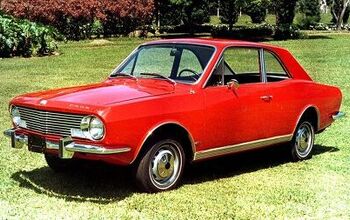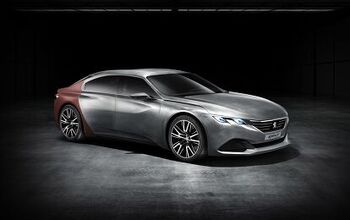Dispatches Do Brasil: 2015

As I sit here and ponder on the year gone by, quite a few salient facts spring to mind. In fact just-auto.com has just written a little ditty that offers some numbers that confirm my observations offered to TTAC readers first. The highlight of the auto year in Brazil is no doubt, the emergence of the New Brazilian Consumer.
However, another very important fact is about to be borne out. According to Matt Gasnier’s numbers at bestsellingcarsblog.com, the Fiat Palio has taken the YTD sales title from the Volkswagen Gol, which has had a stranglehold on the most sold car title since 1987. At the previous clip, this was supposed to have happened in mid-December, but the Palio is selling so furiously it took the YTD title in November.
Another important fact is the re-emergence of General Motors do Brasil. Having shed all Opel snobbishness from their line and going full-Daewoo (I mean GM Korea), GM is now in second place in annual sales. The last time that happened was over a decade ago, and confirms my thinking that GM was right when they did away with the German GM models. A curious mix of Opel products and American and German GM engines with some Brazilian engineering input, now GM Korea with assistance from GM Brazil is the place global GM sources cars. With great success, I might add. Fiat, the most sold car brand in Brazil for 15 years is a row, is under pressure from the Americans (18.9% to GM’s 17.5%).
The Chevy Onix is up 40% in total sales and might even finish ahead of the Gol. The Gol’s debacle serves to underscore Volkswagen do Brasil’s lackluster performance. Having offered up the up! as its main launch for the year, the up! shows just how slow VW is to bend to changing market realities. While a great product, the up! is feature-challenged. Anything the new consumer can’t live without is offered, but at a dear price. Enter the Ford Ka, exhaustively covered on TTAC, and takes a contrary approach to the German car. Offered at a significantly higher price, the cost benefit is undeniable and it gives consumers what they want and then some. Together with the Fiesta and EcoSport, the Ka has afforded Ford a growth of 6% in a market that is down 9%. It has lifted Ford out of the doldrums and sets Renault further back in fifth, and now the French fight with Hyundai to keep that position and do not really creep on Ford anymore.
Fiat meanwhile had a good year. Re-hashing their old models, they have been able to include in their cars, while not upping the price, all the content that keeps them relevant in this changing market. In a year with no relevant launches for the Italians, they not only kept their position, but also lost less ground than main rivals VW. The re-launched Uno has shown it has what it takes and has regained a top 5 position, while the Palio is poised to take the sales crown. Amazingly, in a year where most everyone is down, there are some Fiat products that are sold above list price (like the Grand Siena).
All of these movements bear witness to what I wrote in the new Brazilian consumer article.There are three main reasons that explain the emergence of this new consumer. First is government intervention. As this year began all brand new cars had to be sold with double frontal airbags and ABS. This, despite some failed shenanigans, led to a situation in which factories had to make some tough decisions. Fiat killed the old Uno Mille, VW did likewise to the Gol G4 and Kombi. Similarly GM was forced to up the price of its Celta, rendering it uncompetitive, while Ford had to re-think their strategy.
The second reason was the maturation and growing segmentation of car market segments. The compact category (or subcompact to you Americans, as you like) has now three broad sub-categories. Entry-level, compact and premium compact. Some cars blur those lines and sell in different segments, though no entry-level compact is able to sell as a premium one. In this all-encompassing segment there are vehicles with all manners of body styles, from hatches to sedans, pickups and pseudo-SUVs, minivans and even a station wagon or two. Taken as a whole, this segment still accounts for almost 70% of the new Brazilian car market (according to how I count it).
The final reason I imagined was the greater buying power and affluence Brazilians have earned over the last decade. This is where the just-auto.com article comes in handy. According to them over the span of the last 12 years, new cars sales have exploded 140%. Over this period, average car prices have grown 14% at the lower end, while wages have been buoyed 32% in this same period. Anybody who has lived in Brazil a while can attest to that. I remember when it was said that if a person of African descent was driving a new car, chances were it was stolen. Nowadays, that is considered an antiquated, racist joke, emblematic of the kind of backwards mindset that Brazil has left behind as part of its economic rise.
In my new Brazilian consumer article I mentioned how most private buyers will only buy cars equipped with the most sought after accessories, air conditioning, power steering and electric windows. Also, I explained how connectivity is something more and more expected and even helps explain the growing popularity of GM cars (and likewise, because of its scarcity in them, and connectivity’s super extra deluxe status at VW, one of the reasons they are falling away) as Chevrolet has managed to be the first in this and now most Brazilians associate connectivity in cars to GM.
The just-auto piece gives credence to these assertions. 7 in 10 cars sold in Brazil now have air conditioning, while 60% have some manner of assisted steering. The lower number for assisted steering can be attributed to the lack of this feature in commercial vehicles. Brazilian businessmen continue their abhorrent stinginess in treating their employees. Also, 25% of entry-level cars leave the factory with some sort of connectivity applications, while at the compact level, a little over 35% do. In premium compact cars that number has got to be close to 80%.
In 2014, according to just-auto 60% of cars sold fall into the compact category. Of them 41% were hatchbacks, 18% sedans. Station wagons had just a little over 1 percent, while pickups were a healthy 10 percent. So-called SUVs wooed 9% of buyers while what is sometimes referred to as monocabs (thing like Fiat Doblò know as RAM ProCity in the US or Renault Kangoo) had 4%. The article doesn’t say, but I guess the missing numbers are made up by minivans like Fiat’s Idea or Chevy’s Spin and purely commercial vehicles like the Fiat Fiorino.
Of all these segments, the urban SUV is on the rise. Derek was ahead of the curve when he predicted the rise of the small CUV. It is the “it” segment and many more will come in 2015 offering larger margins to manufacturers and satisfaction to consumers. Newcomers next year will include the highly anticipated Peugeot 2008, Honda HR-V and Jeep Renegade (which I have seen being tested, they’re here, they’re real) as well as possibly something from VW. If the Germans don’t speed up development of the Polo-based Taigun, they could see their market shrinking yet again in 2015. Nonetheless, most analysts expect SUV/CUVs to grow to almost 15% of the market in coming years.
Another segment I consider to have a good chance in 2015 are compact sedans. Growing and almost the same size as what are mid-sizers (Civic, Corolla) here (in wheelbase, width) not to mention larger trunks than the mid-level sedans developed for other markets, compact sedans make very good family vehicles. Pickups continue to grow in popularity, especially among the young. Minivans and monocabs have a small participation, but stable, while the station wagon may finally die next year as no one knows if the Fiat Palio Weekend will last another year.
As to hatches, well they seem safe. I don’t expect them to plummet though their participation is being eroded. Against them the fact most see them as the lowliest form in the car-scape. For them their tight dimensions make them undeniably practical in the snug conditions so prevalent in this contradictorily continental country. They just make sense, and many better off have them as their second or third family cars, while those just entering the new car market still find them easier to grasp financially (insurance, fuel, initial price, maintenance) than bigger offerings.
2015. It should be a good year. In spite of the naysayers, the government has started reigning in some of the excessive spending that has been happening over the last year or so. Brazilians have just been hit with a tax spike. However, credit is still available and with government finances in better order, more credit at less interest should find its way into the market. As companies start placing their new factories on line, growth in the market is fundamental. From a capacity of around 4 million (in place or almost so), the Brazilian industrial car park will be capable of producing almost 6 and a half million cars in three years.
It will be interesting to watch.
Thanks to all TTAC readers who have shown an appreciation for my work in the recent housekeeping articles and all the non-commenting lurkers, too. Greatly appreciate it. As 2015 shapes up as a year of change in this market, there should be lots to write about!
Belated Merry Christmas and Happy and Prosperous New Year to one and all!

More by Marcelo de Vasconcellos
Latest Car Reviews
Read moreLatest Product Reviews
Read moreRecent Comments
- ToolGuy There was a time when in a place called America there were roads, and they were paved, and they were paved smoothly enough for a vehicle like this. Perhaps our next President will bring back that concept.
- ToolGuy I suppose I will listen before commenting. (TG, what a fair-minded dude!)
- ToolGuy "The technology is much more advanced to be better than a role model driver,”• Do any of you know what a "role model driver" is? No, I guess you wouldn't. 😉
- ToolGuy I might be Batman.
- Lou_BC Well, I'd be impressed if this was in a ZR2. LOL


































Comments
Join the conversation
Feliz Ano Novo Marcelo. Best wishes for you and your family.
Feliz 2015 Marcelo! Great post btw.